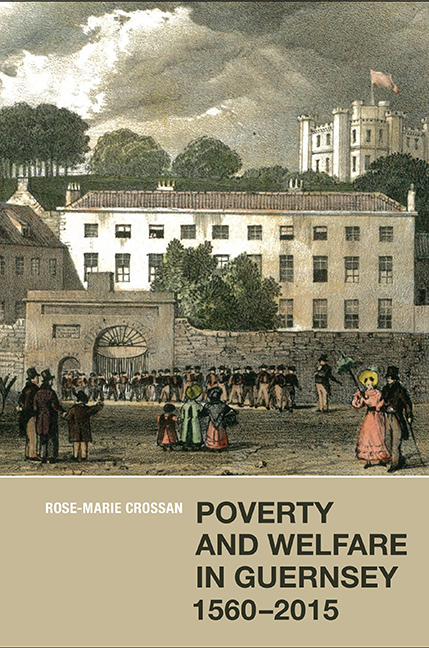Book contents
- Frontmatter
- Dedication
- Contents
- List of Illustrations
- Acknowledgements
- Abbreviations
- Conventions, Note on curren
- Maps
- Introduction
- I Context
- II Welfare
- III Town Hospital
- IV Twentieth Century and Beyond
- Conclusion
- Appendix 1 Writings on Peasant Proprietorship in Guernsey
- Appendix 2 Poor Rates, Indoor and Outdoor Relief Spending, St Peter Port, 1724–1924
- Appendix 3 Parochial Poor Relief in Other Channel Islands
- Appendix 4 Average Year-end Head-counts and Average Annual Admissions and Discharges, Town Hospital, 1700s–1900s
- Appendix 5 Adult Admissions Ascribed to Illness and Accidents, Town Hospital, 1852–1919
- Appendix 6 Relative Proportions of Men and Women in Year-end Head-counts and Annual Admissions, Town Hospital, 1750–1919
- Appendix 7 Annual Averages of Child Admissions and Year-end Numbers, Town Hospital, 1756–1919
- Appendix 8 Over-60s as a Proportion of all Inmates, and Composition by Sex of Over-60s Cohort, Town Hospital, 1756–1911
- Appendix 9 Average Weekly Amounts Purchased per Head, Town Hospital, 1760–1917
- Appendix 10 Timeline: Developments in Poor Relief and Social Security, 1700–2010
- Bibliography
- Index
10 - From Parishes to States
Published online by Cambridge University Press: 18 June 2021
- Frontmatter
- Dedication
- Contents
- List of Illustrations
- Acknowledgements
- Abbreviations
- Conventions, Note on curren
- Maps
- Introduction
- I Context
- II Welfare
- III Town Hospital
- IV Twentieth Century and Beyond
- Conclusion
- Appendix 1 Writings on Peasant Proprietorship in Guernsey
- Appendix 2 Poor Rates, Indoor and Outdoor Relief Spending, St Peter Port, 1724–1924
- Appendix 3 Parochial Poor Relief in Other Channel Islands
- Appendix 4 Average Year-end Head-counts and Average Annual Admissions and Discharges, Town Hospital, 1700s–1900s
- Appendix 5 Adult Admissions Ascribed to Illness and Accidents, Town Hospital, 1852–1919
- Appendix 6 Relative Proportions of Men and Women in Year-end Head-counts and Annual Admissions, Town Hospital, 1750–1919
- Appendix 7 Annual Averages of Child Admissions and Year-end Numbers, Town Hospital, 1756–1919
- Appendix 8 Over-60s as a Proportion of all Inmates, and Composition by Sex of Over-60s Cohort, Town Hospital, 1756–1911
- Appendix 9 Average Weekly Amounts Purchased per Head, Town Hospital, 1760–1917
- Appendix 10 Timeline: Developments in Poor Relief and Social Security, 1700–2010
- Bibliography
- Index
Summary
This chapter will chart the growth of States’ involvement in social welfare after 1900. Its chief source will be the Billets d’Etat containing agendas for States’ meetings and background information on proposals. It will also use contemporary newspaper accounts of States’ meetings and press articles on States’ policies. The first section will deal with the development of a system of social security over the first two-thirds of the twentieth century. The second section will focus on the evolution of a health service.
Towards social security
1900–1940
Prior to the late nineteenth century, public welfare all over Europe was largely controlled by municipalities or communes. The wider state seldom had a role and, where it did – as in England – it was one of co-ordination rather than direct funding or provision. Towards the end of the nineteenth century, as economic competition between nations intensified, a debate arose in northern Europe concerning the desirability of state intervention in securing the well-being of national populations and, one by one, central governments increased their welfare activities. In most European countries, the first government measures concerned the welfare of the national workforce. In 1871, Germany, the pioneer in this field, passed an Employers’ Liability Act making employers in mines, quarries and factories liable to pay compensation for workplace injuries or deaths caused by their negligence. In 1880, the United Kingdom took its own first steps down this path with a similarly titled but more limited Act giving injured workers the faculty of suing their employers. It was also in this area that Guernsey made an initial foray into what might broadly be termed ‘welfare’ legislation, although twenty years later and in slightly different form. The 1900 Law on Compensation to Families of Persons killed in Accidents empowered executors or administrators of the estate of any person whose death had been caused by negligence to sue the negligent party for damages on behalf of the deceased’s family. Although this law was not restricted merely to workplace accidents, it was explicitly described in a local newspaper as ‘an adaptation of the [United Kingdom] Employers’ Liability Act’. Use of the law was not widespread owing to the cumbersome legal process involved, but its passage showed an awareness of developments elsewhere and a nascent acknowledgement that government might have a role, however indirect, in protecting the interests of the disadvantaged.
- Type
- Chapter
- Information
- Poverty and Welfare in Guernsey, 1560-2015 , pp. 241 - 268Publisher: Boydell & BrewerPrint publication year: 2015



